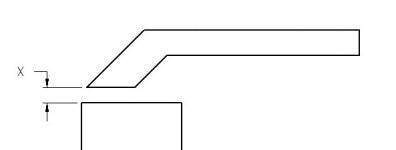CountryBoy19
Stainless
- Joined
- Aug 14, 2012
- Location
- Bedford, IN
I have a 24" Diacro box & pan brake I got VERY cheap. It had been damaged and stripped of its fingers. I repaired the damage and I'm now making fingers. Diacro wants $1600 for a set of fingers, complete brakes go for around $1200-1700 used so I can't see spending that much just on fingers. I already had a big chunk of A2 (large enough to make 2 sets) sitting around for several years.
The brake is rated for 16 ga which means it can easily do double that if bending narrow pieces etc. My question is what should the gap labeled "X" on the picture be?

The OE fingers are shaped like the above photo. Obviously the only time the full bottom of the finger is in contact with the workpiece is when the workpiece is X thickness. If that's the case it seems making the fingers like the OE fingers limits my ability to bend a U-shape. Wouldn't it be more effective to make the fingers like the picture below? Is there any reason not to do that?

The brake is rated for 16 ga which means it can easily do double that if bending narrow pieces etc. My question is what should the gap labeled "X" on the picture be?

The OE fingers are shaped like the above photo. Obviously the only time the full bottom of the finger is in contact with the workpiece is when the workpiece is X thickness. If that's the case it seems making the fingers like the OE fingers limits my ability to bend a U-shape. Wouldn't it be more effective to make the fingers like the picture below? Is there any reason not to do that?


